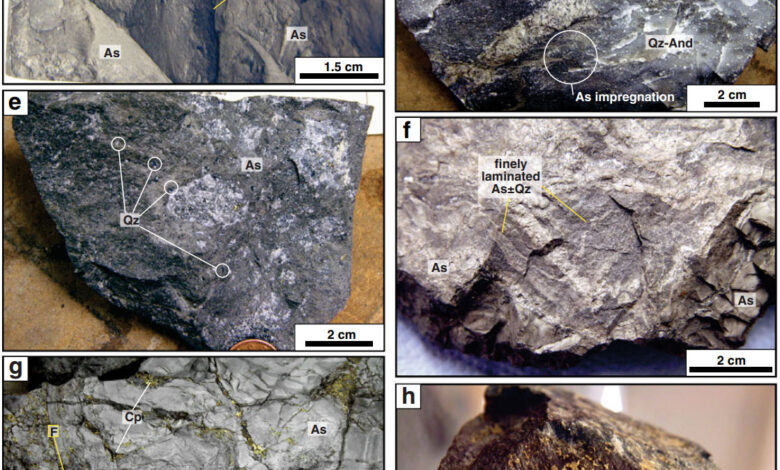Metamorphism of Ore Deposits: The Good, the Bad, and the Ugly

We usually think of rocks as being unchanging, but sooner or later the heat and pressure of tectonic forces, volcanic activity, or just steady burial by more and more rocks forces metamorphoses them into something else. Ore deposits are no exception and understanding how metamorphism has affected deposits in ways positive, negative, or just plain weird can make or break a project.
Introduction
The older a rock gets, the higher the chance it has been subjected to at least some degree of metamorphism. The main causes of metamorphism are heat and pressure, which physically deform rocks and minerals as well as driving chemical reactions. These conditions may also drive the creation and circulation of hydrothermal fluids which are essential to deposits such as orogenic gold.
Diagram of metamorphic facies.
In geology we divide metamorphism into facies, groupings of similar pressure and temperature conditions. The most common, in order of increasing pressure and temperature, are greenschist, amphibolite, and granulite facies. Most rocks change relatively little under greenschist facies metamorphism, but amphibolite and especially granulite facies metamorphism can transform rocks to the point they’re almost unrecognizable. Other metamorphic facies include zeolite and prehenite-pumelyite, very low-grade facies common in seafloor volcanic rocks and deeply buried sedimentary rocks, blueschist and eclogite facies found in subduction zones, and honfels and sanidinite facies found in rocks baked by igneous intrusions.
The Good
Metamorphism may increase the grade of ore deposits in a number of ways. The most common is hydrothermal upgrading, where metamorphic fluids reconcentrate ore to higher grades. Some elements and minerals are more soluble than others, and these may be dissolved, transported, and redeposited by metamorphic fluids. Gold happens to be particularly soluble in greenschist facies metamorphic fluids, and if fluid flow is focused just right gold can be leached from uneconomic areas and concentrated into lucrative high-grade zones.
Metamorphism can also mechanically upgrade deposits. Most ore minerals are sulfides, which tend to be much softer than regular silicate rocks. This softness means that sulfide ore bodies are easily deformed when subjected to high pressures and shearing, in fact shear zones often develop preferentially in sulfides instead of the surrounding silicate rocks. This shearing can sometimes separate the sulfide ore from the host rocks, which may favorably change the grade, location, and geometry of the ore. Pyrite, a common but generally worthless sulfide, is also much harder most ore sulfides, which means pyrite-rich areas of the ore may be sheared off, increasing the overall grade of the remainder. Shear zones also commonly focus fluid flow, increasing the chance of hydrothermal upgrading in sheared sulfide deposits.
Diagram of melting temperatures and metamorphic facies. Heavy grey line marks start of widespread sulfide ore melting; note that this is higher than the melting point of granite in the presence of water.
If things get hot enough, typically well into amphibolite facies, deposits may even begin to melt. It’s very difficult to melt an entire ore body, but certain minerals such as tellurides, sulfosalts, and some native metals have lower melting temperatures and may begin to melt much earlier. Epithermal deposits, which contain many of these minerals, are thought to be the most likely to partially melt. This will produce a small amount of melt which is very rich in metals such as gold, bismuth, tellurium, antimony, and lead. These melts make their way into fractures within or near the main ore body, potentially forming rich accumulations of rare and valuable metals, but they’re generally too small to substantially change the economics of a project. One exception is native bismuth; this metal melts at 261° C, low enough for molten droplets to be carried in hydrothermal fluids. Bismuth has a chemical affinity for gold, and these droplets can circulate through a deposit absorbing gold like a sponge. This process is believed to have created gold-rich veins in the NICO deposit in northern Canada.
Droplets of gold (Au) and bismuth (Bi) melt filling in cavities in arsenopyrite (apy) in the NICO deposit.
The Bad
Many of the processes that may upgrade a deposit can also downgrade it. If re-deposition isn’t focused in a small area metamorphic fluids can transport elements far and wide, leaching out valuable elements and diluting the remaining ore. Faulting can chop up an ore body and move the pieces far apart, leading to a discontinuous deposit which is much harder to mine. This has been a persistent challenge in the Red Lake district, where high grade gold ore can be offset by 100’s of meters by subtle faults leaving very little obvious sign of where it went.
Chemical changes can also impact economics. Metals can escape their original minerals and be redeposited as a different, and possibly harder to process, mineral. Even if the overall grade is unchanged, the transformation of a deposit’s mineralogy can still affect its’ viability.
The Ugly
Perhaps the most common way metamorphism affects a deposit is to obscure its origin. Even if the economics of the ore doesn’t change very much, many of the original minerals and textures will be changed, destroying information on how the ore formed. The effects of low-grade metamorphism can generally be seen through, but at amphibolite and higher grades it becomes increasingly difficult to tell what was there before metamorphism. The origin of strongly metamorphosed deposits such as Broken Hill in Australia and Boliden in Sweden are among the most controversial topics in economic geology.
Strictly speaking, you don’t need to know how a deposit formed to mine it but finding the ore is a lot harder without a clear model to guide exploration.
Case Study: Boliden
The Boliden gold-copper-silver deposit in Sweden produced 3.85 Moz gold, 12 Moz silver, 0.56 Mt arsenic, and 0.12 Mt copper from 1925 to 1966. Boliden is a massive sulfide deposit which has been metamorphosed to lower amphibolite facies and strongly sheared. The deposit is located in a region known for VMS deposits, however the gold grades at Boliden (15.9 g/t) are 10 times higher than most VMS deposits, and the mineralogy is unusual. Much of the gold in Boliden is found in quartz veins and tourmaline-rich zones, which crosscut the main sulfide ore, and ore is also associated with sericite and andalusite alteration: these aren’t found in a typical VMS deposit. The ore also crosscuts stratigraphy, something VMS ore can’t do because it forms at the same time and under the same conditions as its’ host rocks.
Ore textures in the Boliden deposit. A: Sheared sulfide ore. B: Late, unsheared Gold rich quartz vein.
These odd features have sparked a decades-long debate on what Boliden is, and how metamorphism has affected it. Many ideas have been proposed, but one of the most popular is that Boliden is an epithermal deposit, which would explain the high gold grades and most other unusual features. This has major implications for exploration: VMS deposits can only be found in volcanic rocks, whereas epithermal deposits can form in any rock type. If Boliden is epithermal, then rocks which have never been considered worth prospecting before could contain overlooked high-grade deposits.
More recent studies, however, seem to pour cold water on this idea. More thorough mapping reveals Boliden actually is hosted in volcanic rocks, and only appears to crosscut stratigraphy due to the effects of shearing. The sulfides have been deformed by the shearing, but the gold-rich veins haven’t, meaning they formed later than the sulfides. The sericite and andalusite, while not common in VMS deposits, have been reported from a few other locations. The most likely explanation now seems to be that Boliden is a VMS which has been sheared and hydrothermally upgraded, raising the gold grade, masking the deposits’ origin, and leaving us with something that doesn’t easily fit into our standard models. In other words good for mining and bad for exploration, with a heaping helping of ugly on top.
Another example is the Broken Hill deposit, Australia, which is one of the largest (280 Mt at 10% lead, 8.5% zinc, and 148 g/t silver) and most controversial deposits in the world. The more than century-long debate on how Broken Hill formed deserves its’ own article, but the prevailing view today is that it represents a sedimentary exhalative (SEDEX) type deposit which has been metamorphosed to granulite facies and deformed four times in at least two metamorphic events. Lobes of lead rich and zinc rich ore are believed to have been sheared away from each other and transported to their present locations. Metamorphic fluids also altered many of the original minerals as well as transporting in a variety of rare elements, resulting in a complex assortment of rare minerals some of which are found nowhere else in the world.
Conclusion
Metamorphism can affect a deposit in many ways. Hydrothermal fluids, melting, mechanical separation, and changes in mineralogy can improve or harm a projects’ viability, or just make the geology a lot harder to understand. The effects of metamorphism depend on the grade of metamorphism, type of deposit, and local factors making the final outcome hard to predict. Metamorphosed deposits therefore present both unique challenges, and unique opportunities.
- Tomkins, A. G., Pattison, D. R. M., and Frost, B. R. (2007): On the Initiation of Metamorphic Sulfide Anatexis, JOURNAL OF PETROLOGY, 48, 511-535. (academic article)
- Mercier-Langevin, P., McNicoll, V., Allen, R. L., Blight, J. H. S., and Dubé, B. (2013): The Boliden gold-rich volcanogenic massive sulfide deposit, Skellefte district, Sweden: new U–Pb age constraints and implications at deposit and district scale, Miner Deposita, 48, 485–504. (academic article)


